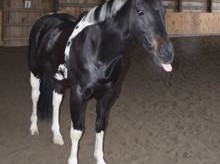Almost all chickens have some external parasites, you just don’t notice them. Neither does the chicken. The birds can live with a few lice crawling under their feathers. So can you. Chickens take dust baths to keep them under control. Lice are soft-bodied and the dirt desiccates them. Add some diatomaceous earth to their favorite dusting area, and you’ll be sure to kill off the lice – the earth is sharp and lacerates the lice. (Be sure to only food-grade DE. Agricultural DE, used to kill slugs, etc, is derived from sea creatures, is microscopically very sharp, and it will shred chicken’s soft tissues if ingested.)
Lice can get out of control and cause severe problems. In the winter, when the ground is frozen and there’s no loose dirt for bathing, the lice population will grow. In the spring, when it’s muddy and warm, the population increases even more. If your hen is elderly and arthritic, or ill and not an enthusiastic bather, you’ll have real problems.
The first place for a lice infestation is near the vent. There can be a lot of lice there and you won’t notice until the skin is bare and red. Like this.
Actually, this is Eleanor’s butt, and it’s been red and bare like this for two years. No one knows why – but it is a dramatic representation of a sad-looking bottom, isn’t it?
Every few weeks I pick my hens up, turn them upside down, and look at the feathers near the vent. Last week’s check showed what I call “lice Q-Tips.”
Those cottony masses at the base of the feathers is a sure sign of lice.
After checking all of the hens and seeing way too much of this (and some crawly bugs, too) I decided to give everyone baths. I set up three bowls – one with a tea tree oil dog shampoo, one with a vinegar and water wash, and the last for a rinse. These bowls were dumped and refreshed several times. It was a hot, sunny day and I set an x-pen up on the grass so after their baths, the girls could dry out on a clean, comfy surface.
Not everyone was equally infested. I wasn’t surprised that my older, less active hens harbored the most lice. On the other end of the spectrum was Lulu, the busiest hen of the lot, who didn’t have a louse on her. Here is her healthy bottom. Notice the many small, downy feathers. They’re so fluffy that you can’t see her skin.
Here’s another view. Isn’t that a nice bottom?
After bathing the hens, their pens got raked and DE was put down. My oldest and most infested hens also got a dusting of commercial louse powder. Eleanor will never have a fluffy bottom, like Lulu, but she’s a lot more comfortable.












